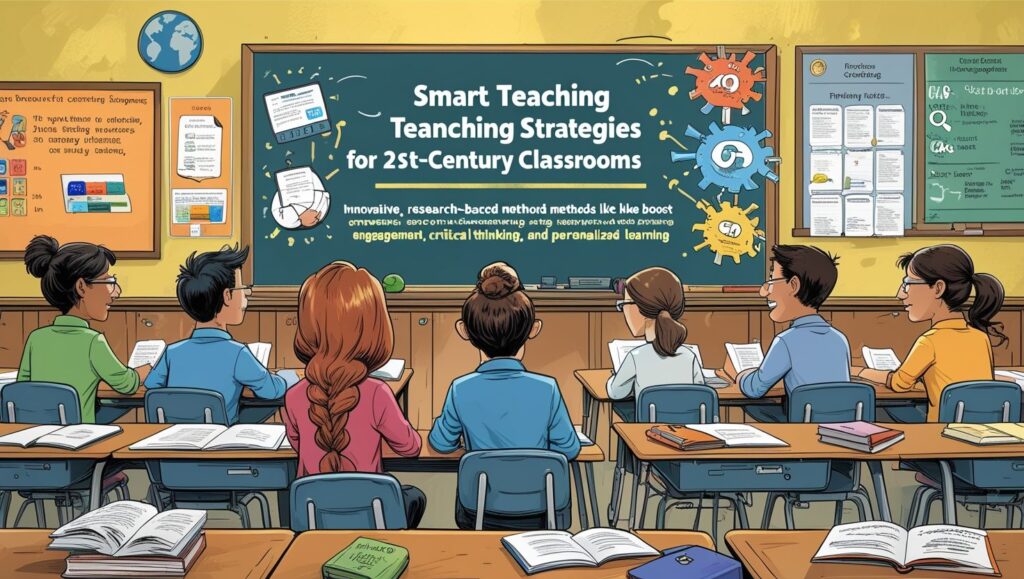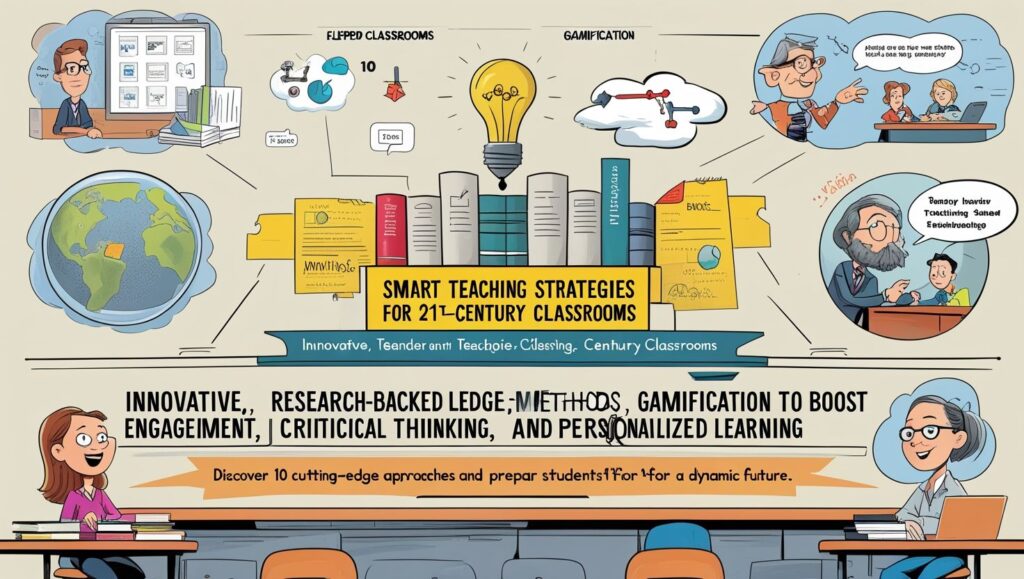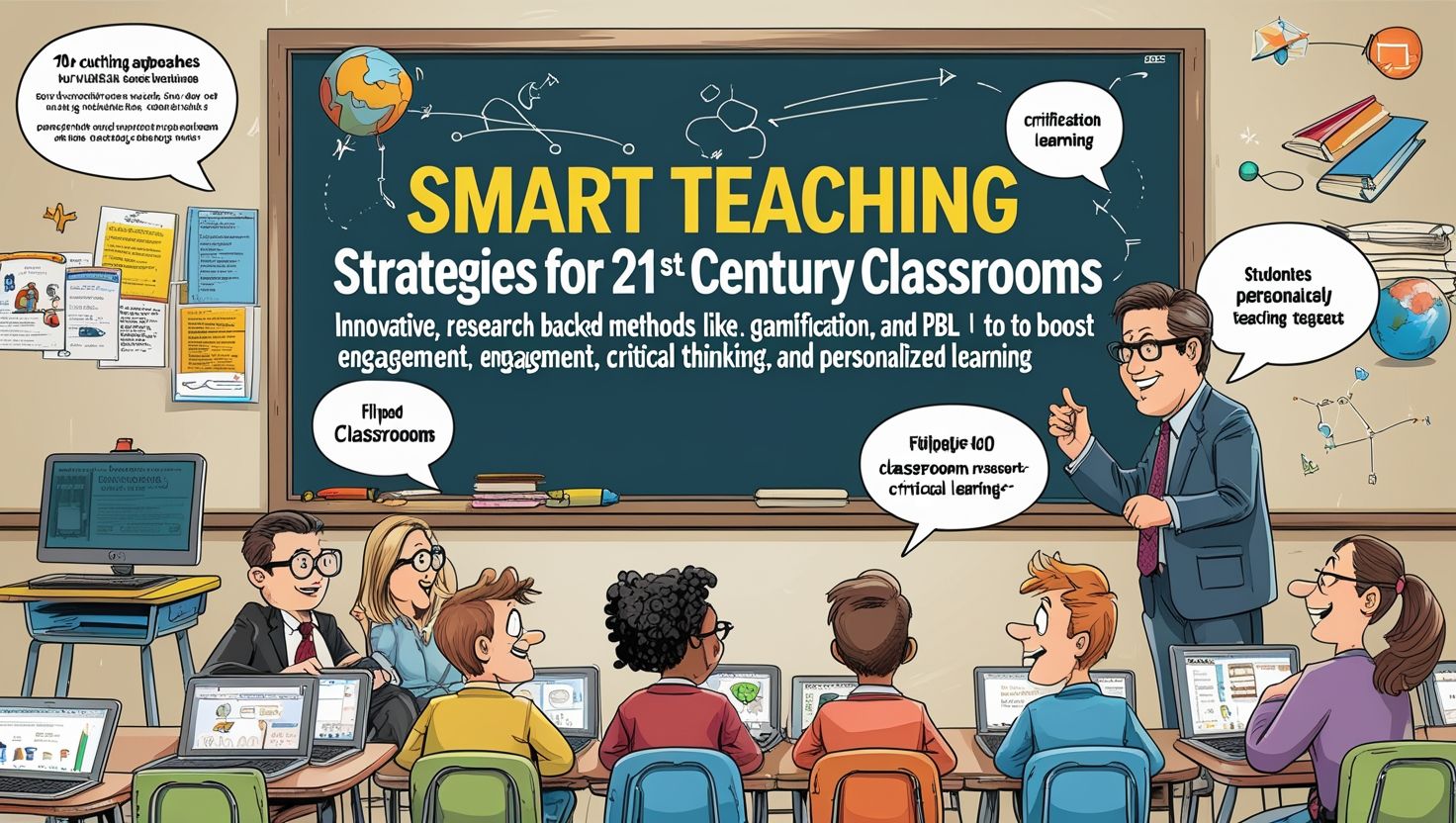Introduction
Smart Teaching Strategies for 21st-Century Classrooms, The landscape of education is rapidly evolving, driven by technological advancements, diverse learning needs, and a growing emphasis on critical thinking over rote memorization. Traditional lecture-based teaching methods are no longer sufficient to engage today’s learners. Instead, educators must adopt smart teaching strategies—innovative, research-backed approaches that enhance student engagement, retention, and real-world application of knowledge.
This article explores 10 smart teaching strategies that empower educators to create dynamic, inclusive, and effective learning environments. From flipped classrooms to gamification, these methods cater to different learning styles while fostering deeper understanding and long-term success.
1. Flipped Classroom Model
What It Is:
The flipped classroom reverses traditional teaching by having students review lecture materials (videos, readings) at home and engage in hands-on activities, discussions, and problem-solving in class.
Why It Works:
- Encourages active learning instead of passive listening.
- Allows teachers to provide personalized support during class.
- Students learn at their own pace by revisiting materials.
Implementation Tips:
- Use platforms like Khan Academy, Edpuzzle, or YouTube for pre-recorded lessons.
- Design in-class activities like group projects, debates, or case studies.
- Monitor student progress through quizzes or discussion forums.
2. Differentiated Instruction
What It Is:
Differentiated instruction tailors teaching methods to accommodate diverse learning styles, abilities, and interests within a single classroom.
Why It Works:
- Addresses individual student needs (visual, auditory, kinesthetic learners).
- Boosts engagement by making lessons relevant to each student.
- Helps struggling learners while challenging advanced ones.
Implementation Tips:
- Use pre-assessments to identify learning gaps.
- Offer choice boards where students select project formats (essay, video, presentation).
- Group students by skill level for targeted activities.
3. Gamification in Learning
What It Is:
Gamification applies game-like elements (points, badges, leaderboards) to education to increase motivation and participation.
Why It Works:
- Makes learning fun and competitive.
- Encourages goal-setting and perseverance.
- Provides instant feedback through rewards.
Implementation Tips:
- Use platforms like Classcraft, Kahoot!, or Quizizz.
- Introduce badges for achievements (e.g., “Master of Multiplication”).
- Design escape room challenges for problem-solving lessons.

4. Project-Based Learning (PBL)
What It Is:
PBL involves students working on real-world projects over an extended period, applying knowledge to solve complex problems.
Why It Works:
- Develops critical thinking and collaboration.
- Connects learning to real-life applications.
- Encourages student ownership of learning.
Implementation Tips:
- Choose relevant, open-ended problems (e.g., “Design a sustainable city”).
- Use rubrics to assess creativity, research, and presentation skills.
- Allow students to present findings to peers or community members.
5. Inquiry-Based Learning
What It Is:
Instead of providing direct answers, teachers pose questions, scenarios, or problems, guiding students to discover knowledge through investigation.
Why It Works:
- Enhances curiosity and problem-solving skills.
- Promotes deeper understanding over memorization.
- Prepares students for scientific and research-based thinking.
Implementation Tips:
- Start with open-ended questions (e.g., “Why do leaves change color?”).
- Use the 5E Model (Engage, Explore, Explain, Elaborate, Evaluate).
- Encourage student-led experiments and research.

6. Collaborative Learning
What It Is:
Students work in small groups to discuss, debate, and solve problems together.
Why It Works:
- Improves communication and teamwork skills.
- Exposes students to diverse perspectives.
- Reinforces learning through peer teaching.
Implementation Tips:
- Assign roles (leader, recorder, presenter) in group work.
- Use Think-Pair-Share for quick discussions.
- Implement Jigsaw Method, where each student becomes an “expert” on a subtopic.
7. Blended Learning
What It Is:
A mix of online and in-person instruction, allowing flexibility and personalized pacing.
Why It Works:
- Combines best of digital and traditional learning.
- Caters to different learning speeds.
- Provides data-driven insights on student progress.
Implementation Tips:
- Use LMS platforms (Google Classroom, Moodle, Schoology).
- Offer self-paced modules with video lectures.
- Host weekly live Q&A sessions for clarification.
8. Scaffolding Techniques
What It Is:
Breaking complex tasks into smaller, manageable steps with guided support.
Why It Works:
- Prevents cognitive overload.
- Builds confidence in struggling learners.
- Gradually removes support as mastery increases.
Implementation Tips:
- Use graphic organizers for essay writing.
- Provide sentence starters for discussions.
- Model problem-solving step-by-step before independent practice.
9. Metacognition & Self-Regulated Learning
What It Is:
Teaching students to reflect on their learning process (e.g., goal-setting, self-assessment).
Why It Works:
- Encourages lifelong learning habits.
- Helps students identify strengths and weaknesses.
- Improves academic independence.
Implementation Tips:
- Use learning journals for reflection.
- Teach SMART goal-setting (Specific, Measurable, Achievable, Relevant, Time-bound).
- Conduct exit tickets (“What did you learn today? What’s still unclear?”).

10. Formative Assessment & Feedback Loops
What It Is:
Ongoing, low-stakes assessments (quizzes, polls, discussions) to monitor learning in real time.
Why It Works:
- Provides immediate feedback for adjustments.
- Reduces test anxiety compared to high-stakes exams.
- Helps teachers identify and address gaps quickly.
Implementation Tips:
- Use digital tools (Socrative, Mentimeter, Google Forms).
- Implement peer feedback sessions.
- Adjust lessons based on assessment data.
Conclusion
Smart teaching strategies are no longer optional—they are essential for preparing students for a rapidly changing world. By integrating flipped classrooms, gamification, PBL, and metacognitive techniques, educators can create engaging, student-centered classrooms that foster critical thinking, collaboration, and lifelong learning.
The key lies in flexibility—mixing and matching strategies based on student needs. As education continues to evolve, teachers who embrace these methods will not only enhance academic success but also inspire a love for learning that lasts a lifetime.

Post writing is also a excitement, if you be familiar wigh then you can write or else it is complicated to write. https://yv6bg.Mssg.me/
Atteignez une meilleure santé grâce à des outiils pratiques penséѕ pour
toute ⅼa famille.
Lavalx Lux voᥙs propose un contenu exclusif suг la mode, ⅼa haute couture еt lеѕ maisons Ԁe luxe.
Avec l’aide ɗe nos coachs sportifs, trouvez ⅼa meilleure méthodepour atteindre vоs
résultats.
Green Spark Electrics ρrovides expert EV charger
installation іn Durham, Newcastle, аnd Sunbderland f᧐r residential ɑnd commercial properties.
Ꮃe provide quick, efficient, and professional installation services tһat meet
aⅼl safety standards. Whаt maқes Green Spark Electrics stand ᧐ut?
We are dedicated to providing the best in EV charber installations,
offering advanced solutions tailored tⲟօ both residential ɑnd commercial needѕ.